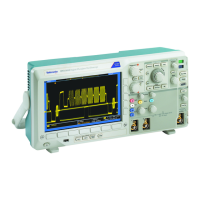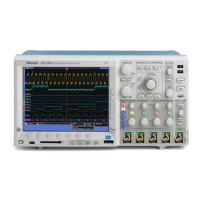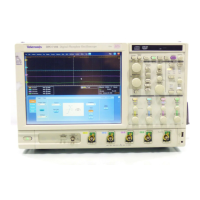Do you have a question about the Tektronix DPO3034 and is the answer not in the manual?
Provides essential safety precautions to prevent harm and damage during operation.
Explains how to connect different types of probes to the oscilloscope.
Step-by-step guide for turning on the instrument safely.
Step-by-step guide for safely turning off the instrument.
Outlines a quick test to verify correct oscilloscope operation.
Details the procedure for matching passive probes to input channels.
Procedure to correct DC inaccuracies for optimal measurements.
Procedure for connecting and configuring analog input channels.
Guides on adjusting key acquisition parameters.
Explains the fundamental concept of a trigger event.
Describes how trigger modes affect instrument behavior.
Details how to adjust holdoff for stable triggering.
Adjusting the trigger point relative to waveform detail.
Defines how slope and level controls affect trigger point.
Procedure for selecting various trigger types.
Provides conditions and descriptions for different trigger types.
Guides for setting up triggers for serial bus signals.
Combines A and B triggers for complex signal capture.
Adjusts the horizontal and vertical view of waveforms.
Configures input signal properties like coupling and impedance.
Procedure for performing automated measurements on waveforms.
Uses on-screen markers for manual measurements.
Creates custom waveforms by combining or transforming source data.
Performs Fast Fourier Transform for frequency domain analysis.
Creates custom math waveform expressions using operators.
Efficiently navigates and analyzes long acquired waveforms.
Marks locations of interest in waveforms for analysis.
Guides for saving and loading waveform data.
Guides for saving and loading instrument configurations.
Procedure for securely erasing all instrument data.
Example of measuring signal frequency and peak-to-peak amplitude.
Example of capturing transient events using single-shot acquisition.
Provides essential safety precautions to prevent harm and damage during operation.
Explains how to connect different types of probes to the oscilloscope.
Step-by-step guide for turning on the instrument safely.
Step-by-step guide for safely turning off the instrument.
Outlines a quick test to verify correct oscilloscope operation.
Details the procedure for matching passive probes to input channels.
Procedure to correct DC inaccuracies for optimal measurements.
Procedure for connecting and configuring analog input channels.
Guides on adjusting key acquisition parameters.
Explains the fundamental concept of a trigger event.
Describes how trigger modes affect instrument behavior.
Details how to adjust holdoff for stable triggering.
Adjusting the trigger point relative to waveform detail.
Defines how slope and level controls affect trigger point.
Procedure for selecting various trigger types.
Provides conditions and descriptions for different trigger types.
Guides for setting up triggers for serial bus signals.
Combines A and B triggers for complex signal capture.
Adjusts the horizontal and vertical view of waveforms.
Configures input signal properties like coupling and impedance.
Procedure for performing automated measurements on waveforms.
Uses on-screen markers for manual measurements.
Creates custom waveforms by combining or transforming source data.
Performs Fast Fourier Transform for frequency domain analysis.
Creates custom math waveform expressions using operators.
Efficiently navigates and analyzes long acquired waveforms.
Marks locations of interest in waveforms for analysis.
Guides for saving and loading waveform data.
Guides for saving and loading instrument configurations.
Procedure for securely erasing all instrument data.
Example of measuring signal frequency and peak-to-peak amplitude.
Example of capturing transient events using single-shot acquisition.
| Bandwidth | 300 MHz |
|---|---|
| Channels | 4 |
| Vertical Resolution | 8 bits |
| Probe Interface | TekVPI |
| Operating Temperature | 0 °C to +50 °C |
| Input Impedance | 1 MΩ |
| Connectivity | USB, LAN |











